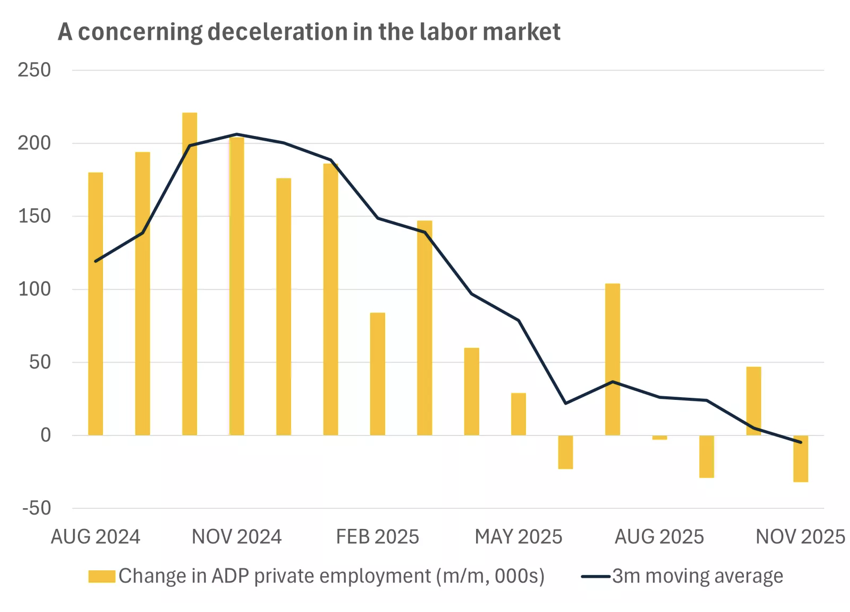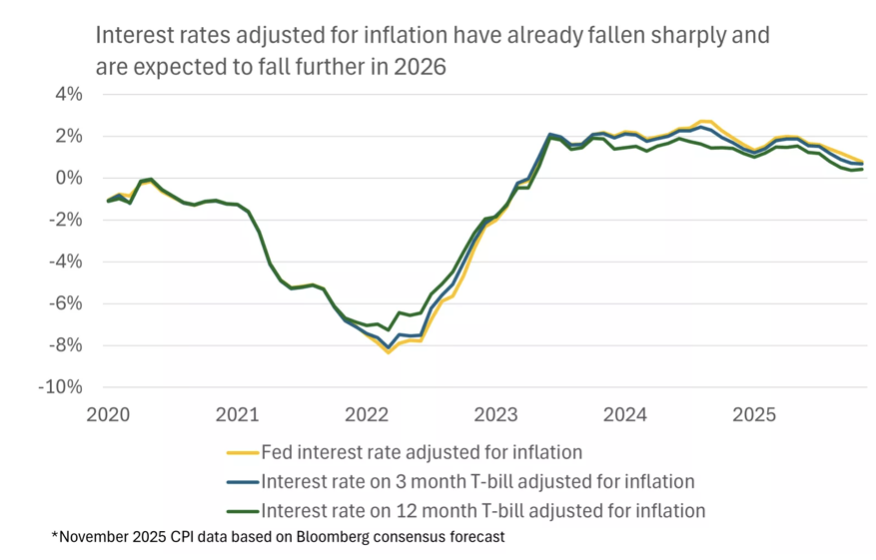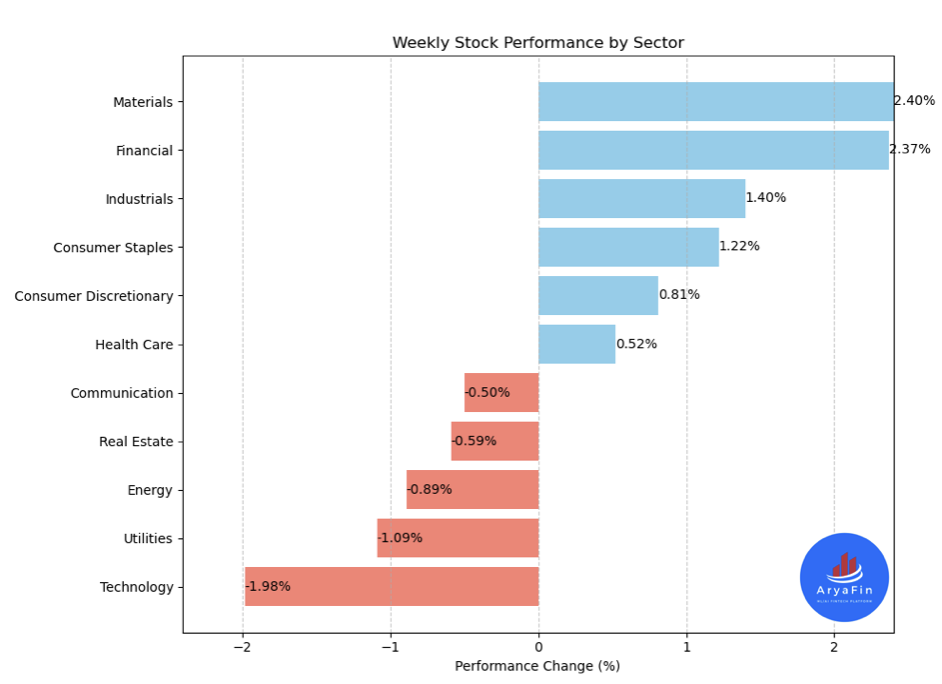Weekly Market Commentary - Dec 13, 2025 - Click Here for Past Commentaries
-
Markets reacted positively to last week's Fed meeting, less due to the widely expected 25 basis point
(0.25%) interest-rate cut and more because of the central bank's broader messaging on the economic and
policy outlook, in our view.
While the Fed appears prepared to pause its cutting cycle in January, Chair Powell's commentary suggests the FOMC will remain responsive to further labour market weakness and that the committee is optimistic inflation will cool.
Against this backdrop, most FOMC members forecast lower rates next year. We see scope for one or two cuts, leaving the fed funds rate in the 3%-3.5% range and removing the drag on the economy from high interest rates in recent years.
Falling interest rates will likely weigh on cash returns in 2026, especially after adjusting for inflation. Investors could consider shifting toward longer-maturity fixed-income investments or increasing allocations to diversified equities as market leadership broadens.
Small-cap equities outperformed last week, as investors continue rotating into lower-valuation stocks that may benefit from Fed easing, while tech names took a breather after disappointments in high-profile earnings reports.
-
In our view, the rally following last week's Fed meeting was not due to the widely expected 25 basis points
(0.25%) interest-rate cut by the FOMC. Instead, investors likely took encouragement from signals on the
policy outlook and news that the Fed will start buying Treasury Bills to support liquidity in short-term money
markets.
The decision to cut was, as anticipated, contested. Two FOMC members, Schmid and Goolsbee, voted against it, citing concerns over elevated inflation. Moreover, individual members' interest-rate forecasts show that four other policymakers were inclined to leave rates unchanged in December, either because they were not scheduled to vote or were convinced to support a cut.
Despite objections, the majority backed a third consecutive cut due to labor market concerns. Hiring has clearly slowed in 2025, and amid disruptions to high-quality data after the government shutdown, another rate cut was seen as a prudent step to guard against risks of deeper deterioration.

-
Given splits in the FOMC and elevated inflation, the market had expected last week's move to be accompanied
by "hawkish" messages that might indicate less chance of future interest-rate cuts.
There were nods in this direction. Subtle changes to the FOMC statement suggest the central bank is preparing to pause its easing cycle, similar to the message in December 2024 before an extended pause. Moreover, Chair Powell indicated that after 175 basis points (1.75%) of rate cuts since September 2024, it may be appropriate to wait and see how the economy evolves before moving again.
However, while these comments seemingly set up a pause in near-term policy easing, they were perhaps not as hawkish as feared.
First, Chair Powell struck a cautious tone on the job market, calling it extremely weak and warning that negative nonfarm-payroll readings are possible. This caution suggests the FOMC will likely remain highly sensitive to further disappointments in the labor market.
Second, FOMC members lowered their inflation forecasts for this year and next, despite becoming more optimistic on growth. This indicates greater confidence that upward pressures on inflation due to tariffs will likely be temporary, and that the economy can rebound in 2026 without sustaining inflationary pressures.
Finally, 12 out of 17 members continue to expect lower interest rates, with the median forecast pointing to one cut in 2026 and one more in 2027. Chair Powell was tight-lipped when asked about the Fed's next step but indicated that it was unlikely to be a hike, maintaining a bias for further rate easing.
-
These indications reassured investors, driving a rally in shorter-term bond markets (which are pricing in
two 25 basis point (0.25%) cuts next year) and a softening in the dollar. They also helped equities,
particularly in the interest-rate-sensitive small-cap sector, which again outperformed big tech names
over the week. This rotation was amplified by a stumble across the Magnificent 7 after Oracle and Broadcom
results raised concerns over AI investment and short-term revenues.
These market moves might also have been amplified by news that the Fed will buy $40 billion in Treasury bills each month until April to support liquidity in money markets. This reflects a technical adjustment to how the Fed sets interest rates, in our view, rather than any shift in policy, such as quantitative easing, whereby the central bank buys longer-maturity securities to lower long-term interest rates and stimulate the economy. However, some investors see a less clear distinction between these policies, interpreting the purchases as a form of policy easing.
-
Looking ahead to 2026, while we think we are approaching the end of the Fed easing cycle, there still
appears to be room for one or two cuts, leaving interest rates between 3% and 3.5%.
A weak labor market, particularly around the start of 2026, should make a case for lower rates, in our view. We receive the delayed November nonfarm payrolls data on Tuesday, with forecasters expecting a modest 50,000 job gain over the month. Further sluggish increases as we move into 2026 would argue for additional easing, in our view, especially given the Fed's sensitivity to these downside risks. We will also watch consumer spending closely for signs that a cooling labor market is starting to weigh on it. Tuesday's October retail sales data will be an important waypoint on this front.
However, we would need to see a sharp deterioration in the economic outlook to justify more aggressive easing. With inflation still running well above its 2% target and expected to do so through 2026, we think the Fed needs to be mindful that too much policy loosening could exacerbate price pressures.
-
There are a few important takeaways from Fed week. First, returns on cash or very short-term
investments—like money-market funds, CDs, and Treasury bills—have already fallen*, and we believe yields
will likely continue to move lower in the year ahead. We think this is especially pressing in an economy
where inflation is running close to 3%, meaning the real return on cash-like investments will likely be
close to zero.
Investors might consider moving up the curve to take advantage of somewhat higher returns. The 10-year U.S. Treasury yield has risen in recent weeks from its 2025 low of 4% to around 4.2% presently. However, we see little scope for government bonds to rally significantly from here. Instead, we expect the 10-year Treasury yield to remain range-bound between 4% and 4.5% through much of 2026. With the Fed nearing the end of its easing cycle, inflation still elevated, and ongoing concerns over the U.S. federal debt outlook, there appear to be few triggers for yields to fall materially lower.
For investors with greater risk tolerance and longer time horizons, we suggest increasing allocations to equities rather than bonds. We believe targeting diversified portfolios of domestic and international stocks is most appropriate presently.
Domestically, we favor large-cap equities to maintain exposure to the ongoing AI investment cycle. However, the recent rotation away from mega-cap tech companies into other sectors and market caps highlights the benefits of diversification and the potential for broadening market leadership. We think mid-cap stocks offer a way to benefit from the steady growth and lower interest rates anticipated next year.
-
Final Words: Market indicates fear. No buys.
Below is last week sector performance report.
Weekly Sector Performance for Dec 8-12, 2025:
$XLE Energy: -0.89%, RSI: 52.76
$XLK Technology: -1.98%, RSI: 47.63
$XLC Communication: -0.50%, RSI: 59.01
$XLY Consumer Discretionary: 0.81%, RSI: 60.24
$XLP Consumer Staples: 1.22%, RSI: 60.82
$XLF Financial: 2.37%, RSI: 68.04
$XLV Health Care: 0.52%, RSI: 56.98
$XLI Industrials: 1.40%, RSI: 60.08
$XLB Materials: 2.40%, RSI: 61.54
$XLRE Real Estate: -0.59%, RSI: 45.12
$XLU Utilities: -1.09%, RSI: 35.56

If you are looking for investment opportunities, you can take a look at our
Hidden Gems
section, and if you want to see our past performance, visit our
Past Performance section. If you are looking for
safe and low cost Exchange Traded funds(ETFs), check out our
ETF recommendations.
Currrent Shiller PE (see below) is showing overbought conditions as index is far above mean/media
and our AryaFin engine is indicating caution. Have a good weekend.

